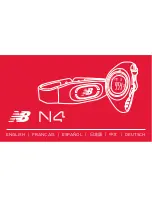
28
Principles of training
For reasons of effectiveness and safety, it is indispensable for you to know certain
physiological parameters required for training. The advice that we provide here is
intended for healthy, active persons who do not present any pathology. We strongly
advise you to obtain the advice of your physician in order to establish your most
precise training zone.
ATTENTION :
Know your limits and do not exceed them !!!
To optimize the benefits of your physical preparation, you must first know your
maximum heart rate
(FCmax)
expressed in beats per minute
(bpm)
.
La FCmax peut s’estimer en fonction du calcul suivant :
FCmax = 220 - votre âge.
During a shape-up program, several training zones will give specific results
corresponding to different objectives. Depending on the intensity of the exercise,
the percentage of the energy coming from the combustion of sugar and that
coming from the combustion of fats changes.
Ex : A 30-year-old athlete training for aerobic endurance in order to increase
his resistance to effort and improve his time in the 10,000 meter run. The most
effective training zone for his objective will be 80 to 90% of his maximum heart rate.
The lower and upper limits of the target zone are calculated by multiplying your
FCmax by the limit percentages of the selected training zone. This equation also
measures your resting heart rate (FC rest), which you can simply measure with
your heart rate monitor early in the morning when you wake up.
Limit of the target zone = FC rest+ intensity %*
(FC max -FC rest)
FCmax=220-30=190 bpm
FC rest = 60 bpm
The upper limit of the target zone is
FC rest + 90%*(Fcmax-FC rest) = 60 + 90%*(190-60) =177 bpm
The lower limit of the target zone is
FC rest + 80%*(Fcmax-FC rest) = 60 + 80%*(190-60) =164 bpm
Fats
Sugars
% FC max
50% - 60%
60% - 70%
70% - 80%
80% - 90%
Moderate activity (walking, hiking…)
Weight control (cardio training, running, in-line skating)
Aerobic zone (endurance training, 10km)
Speed training (400m)

































